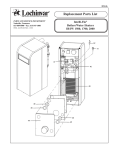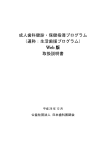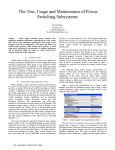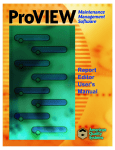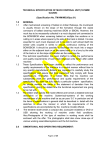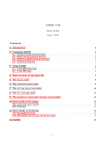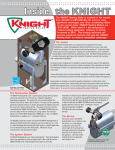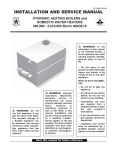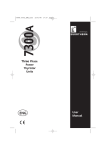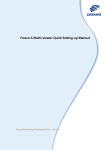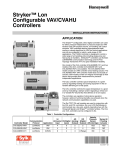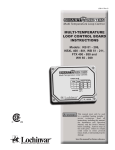Download Intelli Fin Sequencer I & S Manual
Transcript
Intelli-Fin Sequencer IFS-i&s-02 SMP3000 - 3014 Installation Manual Table of Contents General Product Information . . . . . . . . . . . . . . . . . . . . . . .1 Limitations . . . . . . . . . . . . . . . . . . . . . . . . . . . . . . . . . . . . .2 Options Offered on the SMP3000-SMP3002 . . . . . . .2 Options Offered on the SMP3003-SMP3005 . . . . . . .2 Options Offered on the SMP3002, 3005, 3014 and SMP3014 (Boilers Only) Outdoor Air Reset . . . . . . .3 Options Offerered on the SMP3009 - 3012 and SMP3014 - 4-20 mAReset . . . . . . . . . . . . . . . . . . . . .4 Parts List (Items Included in the Kit) . . . . . . . . . . . . . . . . .5 Items to be Provided by the Installer . . . . . . . . . . . . .5 Recommended Tools . . . . . . . . . . . . . . . . . . . . . . . . . .5 One Year Warranty . . . . . . . . . . . . . . . . . . . . . . . . . . .5 Installation . . . . . . . . . . . . . . . . . . . . . . . . . . . . . . . . . . . . .5 Location and Mounting . . . . . . . . . . . . . . . . . . . . . . . .6 Connecting to Electrical Supply . . . . . . . . . . . . . . . . .6 Sensor Location and Wiring Requirements . . . . . . . .7 E-Bus Communications Wiring . . . . . . . . . . . . . . . . .7 LonWorks® Termination Module . . . . . . . . . . . . . . . .8 System Integration . . . . . . . . . . . . . . . . . . . . . . . . . . .8 Troubleshooting . . . . . . . . . . . . . . . . . . . . . . . . . . . . . . . . .9 Sequencer Wiring Diagram . . . . . . . . . . . . . . . . . . . . . . . .10 Table of Figures Figure 1 - Commissioning Label . . . . . . . . . . . . . . . . . . . .5 Figure 2 - Daisy Chain Connection . . . . . . . . . . . . . . . . . .6 Figure 3 - Rear E-Bus Connection . . . . . . . . . . . . . . . . . . .6 Figure 4 - Wire Termination for E-Bus Connection . . . . .6 Figure 5 - Sequencer - Rear View . . . . . . . . . . . . . . . . . . .6 Figure 6 - Sequencer - Inside View . . . . . . . . . . . . . . . . . .7 Figure 7 - Primary/Secondary Loop . . . . . . . . . . . . . . . . . .8 Figure 8 - Sequencer Wiring Diagram . . . . . . . . . . . . . . . .10 General Product Information The SMP3000 - 3005 Sequencing packages are an effective way to improve efficiency, reduce maintenance, and enhance the longevity of a hydronic system. NOTE: This controller MUST be designed to operate with a primary/secondary full flow boiler loop. This is due to the fact that variable speed changes the operating characteristics. Intelli-Fin boilers and water heaters give system designers “conventional” sequencing options such as first on/last off and first on/first off which are offered as part of this standard sequencing package, however, the Intelli-Fin also provides a whole host of optional sequencing packages on the SMP3003 SMP3005, SMP3009 - SMP3010 and the SMP3011 SMP3014. Multiple sequencing options are available. The specific software programming required to sequence multiple boilers must be specified at the time the appliances are ordered. The sequencing options are used to control how multiple boilers or water heaters are cycled to meet system demand. The sequencing options are programmed into an Excel 10 controller at the factory based on the number of selectable sequencing algorithms ordered. The desired method of sequencing multiple boilers or water heaters may be selected from the screen of the Command Display. There are up to five sequencing options that are selectable from the Command Display, based on the sequencing package purchased. One sequencer has the capability of handling up to 16 boilers or water heaters. NOTE: Separate sequencers must be used if desired to control both boilers and water heaters simultaneously. Save this manual for future reference. Efficiency Optimized with Time Equalization – This is the same as “Efficiency Optimized” but the lead/lag is based on boiler or water heater run-times. The boilers or water heaters will be sequenced to equalize run-times to within 24 hours over a years time period. If no opportunity is given to cycle, the control will not interrupt action to equalize run-time. WARNING: Verify the correct sequencing package is used for the correct application. LIMITATIONS Efficiency Optimized Control Algorithm Operation These installation instructions are for sequencer kits SMP3000 SMP3014. These kits are for use with Intelli-Fin Models IB/IW 1500-2000 and can be used for the sequencing of up to 16 units. The “efficiency optimized control algorithm” controls boilers to achieve maximum operating efficiency by having boilers firing at the lowest rate possible and still statisfying the load. Boiler efficiency is highest at the lowest firing rate and lowest at the maximum firing rate. At lower firing rates more heat is transferred from the combustion gases through the heat exchanger to the water inside the boiler. The combustion gases are flowing slower past the heat exchanger and give up more heat. Model(s) Boiler IB 1500, 1700, & 2000 Water Heater IW 1500, 1700, & 2000 The efficiency algorithm works as follows: One firing rate is commanded to all boilers. As soon as the firing rate to all boilers ON exceeds that required to bring on a new boiler at the minimum firing rate, a new boiler is ignited and begins firing. Once the new boiler is operating and supplying heat, all boilers are modulated down to a new minimum to compensate for the new boiler being turned ON. A similar thing happens when a boiler is subtracted from operation. When all boilers are firing at the minimum and the load is decreasing, a boiler is shut OFF and the remaining boilers ON are modulated up to satisfy the load deficit. Options Offered on the SMP3000 - SMP 3002 Standard Sequencing Packages SMP3000 – Standard Sequencing Package for Water Heaters SMP3001 – Standard Sequencing Package for Boilers SMP3002 – Standard Sequencing Package for Boilers with Outdoor Air Reset First On – First Off – This is a lead/lag control functionality. The sequencing of the boilers or water heaters is based on the total loop load with added units being brought ON when the units that are running are at 100% and the loop load is not being met. Boilers or water heaters are turned OFF when the loop load falls and the first boiler or water heater ON is at minimum load. The “efficiency optimized control algorithm operation” can best be illustrated with the following example: Example: Assume we have a four boiler system, all boilers are initially OFF and a load change occurs resulting in an overall load of 20%. One boiler firing at maximum can satisfy only 25% of the load. The first boiler is ignited and modulates up to a 50% firing rate. At this point a second boiler is ignited. One boiler firing at 50% is equivalent to two boilers firing at 25%. Both boilers modulate to 37.5% and the third boiler is ignited. Two boilers firng at 37.5% is equivalent to three boilers firing at 25%. All three boilers now modulate to a firing rate of 27% satisfying the overall load of 20% at maximum efficiency with no unnecessary cycling. Now assume the load changes to 15%. All three boilers are modulated down to 25% and temperature is still rising. One boiler is commanded OFF and the remaining two boilers modulate up to 30% and satisfy the load. First On – Last Off – This is a simple first on / last off without rotation of the lead boiler or water heater. Options Offered on the SMP3003 SMP3005 Custom Sequencing Packages In addition to the sequencing options listed above in the Standard Sequencing Packages, the Custom Sequencing Packages offer the following sequencing enhancements: SMP3003 – Custom Sequencing Package for Water Heaters SMP3004 – Custom Sequencing Package for Boilers SMP3005 – Custom Sequencing Package for Boilers with Outdoor Air Reset NOTE: This explanation has been idealized. In actuality, the control algorithm assumes the switching firing rate is 33%. This assumption prevents unnecessary cycling resulting from load fluctuations that would be associated with a 25% switching firing rate. Efficiency Optimized – The lead/lag will be based on first on/first off lead/lag. The overall efficiency will be optimized to run the boilers or water heaters at their highest efficiency. Highest efficiency occurs at the minimum loading for each boiler or water heater. Therefore, this option will add boilers or water heaters when the load reaches a point where the next boiler or water heater can run at minimum load. Efficiency Not Optimized Control Algorithm Operation The “efficiency not optimized control algorithm” controls boilers to achieve the minimum number of boilers firing at one time. Before a new boiler can be commanded ON, all the boilers cur2 rently ON are at a firing rate of 100% and the load is not being satisfied. If the load can be satisfied with this new boiler modulating above the minimum, all the previously ON boilers are held at a firing rate of 100% and the new boiler modulates up and off, the boilers that are firing at the maximum are modulated back slightly so that the new boiler will modulate above the minimum and not cycle. For the “efficiency not optimized” case, all boilers are at or near the maximum firing and one boiler is modulating to satisfy the load fluctuations. A better example would be to assume that we have a four boiler system, all boilers are initially OFF and a load change occurs resulting in an overall load of 60%. The first boiler is turned ON and modulates to 100%. The second boiler is turned ON and the boiler is modulated to 100% and the load is still not being satisfied. The third boiler is turned ON and modulates to 40% satisfying the load. Now assume the overall load changes to 40%. The third boiler is turned OFF, the second boiler is modulated down from 100% to 60% and the first boiler remains at 100%. The previous example used to illustrate how “efficiency optimized” works is not a good example for the “efficiency not optimized” case. If it were applied to that example, only one boiler would ever come ON. For an overall load of 20%, one boiler would be ON and at a firing rate of 80% and for an overall load of 15% the firing rate would be 60%. Notes for Both Approaches: In the previous examples, the boiler that would be turned OFF was based on first on/last off for simplicity. Also in this explanation, the term boiler was used, but the same holds true for a water heater. Options Offered on the SMP3002, SMP3005, SMP3013, and SMP3014 (Boilers Only) Outdoor Air Reset Sequencer panels have the option of being equipped with Outdoor Air Reset, which automatically readjusts the temperature of the boiler loop to provide additional heat during cold days and provide for shutdown of the system on warmer days when heating is not required. W ater Temp . °F INTELLI-FIN SEQUENCER OUTDOOR AIR RESET VALUES SMP3002, SMP3005, SMP3013 & SMP3014 - BOILERS ONLY Typical Values Shown 180°F Max. Reset Temp. Calculated Setpoint Setpoint Temp. 130°F Shutdown Outdoor Air Temp. °F O.A. Min. -10°F O.A. Max. Factory Defaults Item Description Maximum Reset Temperature Field Adjustable Using Command Display 70°F Setpoint Temperature Lockout 60°F Special Factory/ Field 180°F 130°F O.A. Minimum -10°F O.A. Maximum 60°F O.A. Lockout 70°F Factory Set (1) NOTE: 4-20mA RESET HAS PRIORITY OVER OUTDOOR AIR RESET. LBL2226 REVSequencer Boiler Interface Controller + + + + + + + + Field Provided Sensor Wiring Polarity Insensitive OA SENSOR 3 2 2 1 1 Mounting Bracket Outdoor Air Sensor CONNECTIONS "SEE ACTUAL WIRING DIAGRAM FOR DETAILS" ON PAGE 10 OF THIS MANUAL. 3 Options Offered on the SMP3009, SMP3010, SMP3011, SMP3012, and SMP3014 4-20mA Reset Sequencer panels have the option of being equipped to handle a 4-20mA reset signal from a Building Management System. When equipped as such, the sequencer has the ability to respond to variations in the 4-20mA signal by either raising or lowering the water temperature or shutting down the units. INTELLI-FIN SEQUENCER 4-20mA VALUES SMP3009, SMP3010,SMP3011, SMP3012, SMP3013 & SMP3014 Not connected or 0mA signal. Typical Values Shown ShutDown Setpoint Temp. 130°F Off 130°F 0-3mA 3-5mA 6mA Setpoint Temp. 180°F Max. Reset. Temp. Calculated Setpoint 7 - 19mA 20mA External 0mA to 20mA Signal mA VALUE TO SEQUENCER SEQUENCER ACTION TAKEN 0-3mA USE SETPOINT 3-5mA SHUTDOWN ALL UNITS 6mA RUN AT SETPOINT 7-19mA LINEARLY RUN BETWEEN SETPOINT AND MAX. RESET TEMP 20mA RUN AT MAXIMUM RESET TEMP. Factory Defaults Item Description Field Adjustable Using Command Display NOTE: Maximum Reset Temperature Setpoint Temperature SpecialField Values 180°F 130°F 4-20mA RESET HAS PRIORITY OVER OUTDOOR AIR RESET. LBL2225 REVBoiler Interface Controller + + + + Negative Input (-) # 11 + Positive Input (+) # 10 + + + Sequencer Black + Red 4-20mA Output From BMS Polarity Sensitive OPTIONAL 4-20ma INPUT Com 0-20mA Building Management System CONNECTIONS "SEE ACTUAL WIRING DIAGRAM FOR DETAILS" ON PAGE 10 OF THIS MANUAL. 4 COMMISSIONING INSTALLATION Commissioning will be done at the factory and cannot be changed in the field. Consult factory for more details. Please reference the Commissioning Label for applicable serial numbers, as depicted below in Figure 1. The sequencer is supplied in a separate control enclosure that will be connected to multiple appliances via an E-bus connector on the rear of each appliance. The sequencer comes mounted in an enclosure that requires a field installed 120VAC power source. An optional enclosure with a sub-base and 24VAC power supply is available to allow remote mounting of a Command Display adjacent to the sequencer. Connection between multiple Intelli-Fin appliances is accomplished via an E-bus connection. An E-Bus terminal is provided on the rear of each appliance as depicted in Figures 2 and 3. The minimum specification for the communications wire is for 2 a Level IV, 22 AWG (0.034 mm ) plenum or non-plenum rated (as applicable), unshielded, twisted pair, stranded wire. Use plenum rated wire where required. See “Wire Requirements” in your Intelli-Fin Installation and Service Manual for a listing of manufacturers who supply communication wire meeting this specification. The twisted pair wire is used to make daisy chain connections (see Fig. 2) between the E-Bus terminals on multiple appliances. The E-Bus connection uses a Free Topology Transceiver (FTT) to support a polarity-insensitive free topology wiring scheme for star, loop and/or bus wiring. The maximum number of nodes per segment is 60. The maximum number of nodes in a two-segment FTT network is 120, when using a repeater between the two segments. Consult factory for additional information on interface wiring of multiple Intelli-Fin appliances to an Energy Management System (EMS). Wiring to the terminal blocks is as follows: NOTE: When attaching two or more wires to the same terminal, twist wires together. Deviation from this rule can result in improper electrical contact. (Reference Figure 4, when performing the following steps.) Figure 1 Commissioning Label PARTS LIST (ITEMS INCLUDED IN THE KIT) 1. Strip ½ inch (13mm) insulation from the conductor. 2. Insert the wire in the required terminal location and tighten the screw to complete the termination. 3. If two or more wires are being inserted into one terminal location, twist the wires together a minimum of three turns before inserting them. 4. Cut the twisted end of the wires to 3/16 inch (5mm) before inserting them into the terminal and tightening the screw. 5. Pull each wire in all terminals to check for a good mechanical connection. • (2) Remote Mounting Sensors • (2) Bulbwells • (Option) Outside Air Sensor • (Option) Outside Air Mounting Bracket • 22 AWG Communications Wire - 25ft. shipped with the unit Items to be Provided by the Installer • Mounting Screws • 18 Gauge Shielded Cable (recommended for noisy environments) For additional components used to interface multiple appliances, see the Intelli-Fin Installation and Service Manual provided with the appliances. RECOMMENDED TOOLS FTT networks are flexible and convenient to install and maintain. However, it is imperative to plan the network layout and to create and maintain accurate documentation. Careful planning and up to date documentation facilitates compliance verification and future FTT network expansion. It also minimizes unknown or inaccurate wire run lengths, node to node (device to device) distances, node counts, total wire length, inaccurate repeater locations, and misplaced or missing terminations. • Small Flathead Screwdriver • Medium Phillips and/or Flathead Screwdriver • Pliers • Wire Cutters/Strippers • Drill ONE YEAR WARRANTY Factory warranty (shipped with sequencer) does not apply to equipment improperly installed or improperly operated. Note: A System Integrator’s Guide along with dedicated resource files is located on our website at www.lochinvar.com, select Boilers and then click on the Intelli-Fin picture. Experience has shown that improper installation or system design, rather than faulty equipment, is the cause of most operating problems. 5 Rear E-Bus Connection Figure 2 Daisy Chain Connection run lengths, node to node distances, node counts, total wire length, inaccurate repeater locations, and misplaced or missing terminations. Choose a location in a convenient interior or place where the controls and connections are accessible and a 6” clearance can be maintained above the sequencer. This clearance is needed to allow access to the Neuron ID switch on the sequencer. Mount the sequencer to the wall with four (4) mounting screws (not supplied) through the mounting holes in the base as shown below in Figure 5. Figure 3 Rear E-Bus Connection STRIP 1/2" FROM WIRE TO BE ATTACHED. 1/2" (13MM) TWIST WIRES TOGETHER WITH PLIERS (MINIMUM OF THREE TURNS) INSERT TWISTED WIRES UNDER TERRMINAL AND TIGHTEN. CHECK FOR A GOOD MECHANICAL CONNECTION. Figure 5 Sequencer - Rear View Connecting to Electrical Supply Figure 4 Wire Termination for E-Bus Connection The sequencer contains one or more 120VAC to 24VAC step down transformer(s); 24VAC is used to power the electronic components of the sequencer (Fig. 6). Supply a dedicated 120VAC input source to the transformer leads. The amp draw of the sequencer is less than 15 amps. Location and Mounting It is recommended that the sequencer be mounted in close proximity to the units in order to avoid unknown or inaccurate wire 6 RLY2715 Inlet/Outlet Control RLY2043 Interface Board Commissioning Label Wiring Diagram E-Bus Communications Wiring •Unswitched 24 V ac power wiring can be run in the same conduit as the E-Bus cable. •All field wiring must conform to local codes and ordinances. •Do not use different wire types or gauges on the same LonWorks® network segment. The step change in line impedance characteristics will cause unpredictable reflections on the bus. When using different types is unavoidable, use a router at the junction. Transformer Ground Terminal Connection 4-20 mA Reset Label (Optional) Outdoor Air Reset Label (Optional) Figure 6 Sequencer - Inside View Sensor Location and Wiring Requirements Note: All wiring must comply with applicable codes and ordinances. 1. Disconnect external power before wiring to prevent electrical shock or equipment damage. 2. The sequencer comes with two (2) remote mount sensors that are shipped loose. These sensors should be installed in the bulbwells that have also been shipped loose. 3. The bulbwells should be installed (1 each) in the supply and return lines of the primary system piping. a. The supply sensor should be located at least four (4) pipe diameters downstream of the last connection from this secondary piping loop to the primary loop (Fig. 7, page 8). b. The return sensor should be located at least four (4) pipe diameters upstream of the first connection from this secondary piping loop to the primary loop (Fig. 7, page 8). •The use of shielded cable for LonWorks® network wiring runs is not recommended. The higher capacitance of the shielded cable will cause degradation of communications throughput. In noisy (high EMI) environments, avoid wire runs parallel to noisy power cables or lines containing lighting dimmer switches, and keep at least 3 inches (76mm) of separation between noisy lines and the LonWorks® network cable. However, in some cases where high electrical noise exists, the use of shielded cable may be unavoidable. If it is felt that shielded cable is necessary, consult the factory or a qualified LonWorks® installer for direction. •Make sure that neither of the LonWorks® network wires are grounded. •Communications wire connections are polarity insensitive. Sensor wiring: 14 to 20 AWG (2.0 to 0.5 mm2) for runs >100 ft. (30 m) twisted pair or shielded cable is recommended. 4. Wiring between the sensor and the sensor connector leads on the sequencer should be as short as possible and be made with 18 gauge shielded cable (recommended but not required). 5. If the sequencer has been ordered with Outside Air Reset, an outside air sensor and sensor mounting bracket will be shipped with the sequencer. 6. Mount the bracket to an exterior wall with four (4) mounting screws (not supplied) through the mounting holes in the bracket. 7. Install the sensor into the mounting bracket. 8. Wiring between the sensor and the sensor connector leads on the sequencer should be as short as possible and be made with 18 gauge shielded cable. All wiring must comply with applicable code and ordinances. IMPORTANT: All field wiring must conform to local codes and ordinances or as specified on installation wiring diagrams! 7 Intelli-Fin Sequencer SYSTEM LOOP Temp Sensor 10ft from first boiler System Pump(s) 12" max or 4 pipe diameters Boiler #1 Boiler #2 Boiler Pumps on/off with boiler(s) Figure 7 Primary/Secondary Loop LONWORKS® TERMINATION MODULE 1. One or two LonWorks® Network Termination Modules, part number 209541B are required for a LonWorks® network with FTT devices on it, depending on the configuration. 2. Double termination is required only when the network is a daisy-chain configuration and the total wire length is greater than 1640 ft. (500 m). 3. The maximum lengths described in Step 2 must be adhered to for either a daisy-chain or free topology LonWorks® network layout. System Integration The intent of these wiring guidelines is to cover the connections made to Lochinvar boilers. It is highly recommended that you consult a qualified LonWorks® installer for integration of the Lochinvar boilers into a LonWorks® based system. 8 TROUBLESHOOTING SITUATION Sequencer does not power up Sequencer does not communicate with boilers POSSIBLE CAUSE(S) CORRECTIVE ACTION No 120VAC to transformer. Check wiring to transformer from supply. No 24VAC output from the transformer. Replace transformer. No continuity through the Run/Stop switch. Turn the switch ON. Correct the wiring at the switch or replace switch. Faulty interface board(s). Replace interface board(s). Faulty sequencer. Replace control.* Faulty wiring between sequencer and boilers. Correct wiring. Building Energy Management System (EMS) Correct EMS. has boilers locked out. Temperature sensors reading erratically Bypass jumper not plugged into interface board. Replace jumper plug. Outside air lockout engaged on units with I/O reset. Disconnect outside air sensor or wait until outside air temperature drops below 70°F. Poor wiring connections at sensors or sequencers. Correct wiring. Sensor wiring routed with 120VAC power lines. Re-route sensor wiring. Sensor located near electrical motors. Move sensors. Faulty interface board. Replace interface board. Faulty sequencer. Replace control.* Faulty sensor. Replace sensor. *Note: Replacement of the control will require domain, subnet and node addresses for all appliances in this network (appliance will have to be recommissioned - consult factory). This must include all Intelli-Fin units and any Command Displays. 9 SEQUENCER WIRING DIAGRAM Y BL 8 9 LEFT SIDE WING BOARD 7 3 6 2 5 1 SEQUENCER CONTROLLER BIC V2.0.x BK RIGHT SIDE WING BOARD 5 4 3 2 1 COMMUNICATION CABLE 3 1 2 1 2 1 2 1 2 OA SENSOR 1 2 OUTLET SENSOR G BK W STOP/RUN SWITCH INLET SENSOR BK BK ENABLE SWITCH R OPTIONAL GROUND POS (+) CHASSIS GROUND BL Y 14 13 12 11 6 5 4 3 E-B US A 1 - 6 22VDC V/m a O U T A1 - 5 G N D V/ma A 1 -1 G N D A 1 -2 OH M OH M 4 9 D I- 1 1 8 G ND 2 7 D I- 2 3 A 1- 4 OH M D I- 3 NEG (-) GN D OPTIONAL A 1 -3 OH M G ND 2 8 O UT 26 D I -4 1 16 7 OU T 2 7 1 17 6 OU T E GN D 24VAC 2 18 5 OU T 2 1 1 1 19 4 O UT 28 SEQUENCER SCHEMATIC/WIRING DIAGRAM 2 20 3 O UT 24 29 25 30 10 24VAC - 40VA TRA NSFROMER Inter nally Fused INPUT 3 15 21 2 O UT 1 BK R OPTIONAL 4-20mA Reset CONNECT TO SEQUENCED UNITS NE G POS OPTIONAL RETURN SUPPLY OUTDOOR AIR SENSOR OUTLET SENSOR INLET SENSOR EXTERNAL FIELD CONNECTIONS 120 VAC 15 AMP 10 J ACK J3 22 1 OU T GND LBL2139 REV C Figure 8 Sequencer Wiring Diagram E-B US 23 24 24 VAC VAC CO M 31 NOTES 11 12/03 - Printed in U.S.A.












